
Recently Rated:
Stats
David Western will be appearing, speaking on the lovespoon carving tradition and showing his work, including the Left Coast Eisteddfod lovespoon - which David will award at the event - at the Left Coast Eisteddfod in Portland, Oregon on Friday, August 21 and Saturday, August 22, 2009. Get your tickets now.
As I've been compiling this little blog following the twists and turns of carving a lovespoon for the Left Coast Eisteddfod, I've received a number of emails from fellow carvers, lovespoon enthusiasts and a few people who are 'just interested' wanting to know how I got into this and what my inspirations are.
I can tell you that I basically fell into lovespoon carving. Although I have been aware of what they are since childhood, and have tinkered with carving them since my teens, the really serious obsession (or as I prefer to call it, professional interest) with lovespoons is about 10 years old now.
 My main inspirations were, and still are, the lovely antique spoons housed at the National History Museum of Wales at St Fagans (near Cardiff). I always make time for a day or two at the museum studying these little gems of fervent workmanship whenever I am in Wales. A finer introduction into the craft cannot be found anywhere else (except maybe in my book The Fine Art of Lovespoon Carving - how's THAT for a shameless plug??). I encourage anyone keen on lovespoons who plans on visiting Wales to make time for this marvelous museum. Even if you could care less about lovespoons, the outdoor museum is chock-a-block with tremendous things to see. But if I were to single out one spoon which above all others has been my greatest source of inspiration and as acted as a beacon guiding me to strive to constantly improve both my carving and my design it would be this one.
My main inspirations were, and still are, the lovely antique spoons housed at the National History Museum of Wales at St Fagans (near Cardiff). I always make time for a day or two at the museum studying these little gems of fervent workmanship whenever I am in Wales. A finer introduction into the craft cannot be found anywhere else (except maybe in my book The Fine Art of Lovespoon Carving - how's THAT for a shameless plug??). I encourage anyone keen on lovespoons who plans on visiting Wales to make time for this marvelous museum. Even if you could care less about lovespoons, the outdoor museum is chock-a-block with tremendous things to see. But if I were to single out one spoon which above all others has been my greatest source of inspiration and as acted as a beacon guiding me to strive to constantly improve both my carving and my design it would be this one.
 For me, this spoon epitomizes all that is great about the lovespoon. Masterfully and elegantly carved, the spoon appears deceptively simple, yet every feature is flawlessly carved and the represents the very highest level of craftsmanship. If you want a spoon that 'has it all'...this is the one. Whoever the unknown craftsman was who made this brilliant offering, I sincerely hope that he won the heart of his intended and lead a long, happy and productive life! He deserves it!
For me, this spoon epitomizes all that is great about the lovespoon. Masterfully and elegantly carved, the spoon appears deceptively simple, yet every feature is flawlessly carved and the represents the very highest level of craftsmanship. If you want a spoon that 'has it all'...this is the one. Whoever the unknown craftsman was who made this brilliant offering, I sincerely hope that he won the heart of his intended and lead a long, happy and productive life! He deserves it!
 After that masterwork, this little spoon may seem like the 'ugly duckling', but what I love and find so inspiring about this spoon is the passion which seems to almost emanate from its fibres! Lofty talk, I know, but despite its rather rudamentary craftsmanship and design, this spoon has tremendous emotion. Made with the simplest of tools by someone in the deepest thrawl of love, the bowl is exquisitely formed, showing an amateur carver giving it his very best effort . For 'feeling', this spoon has always rated as one of the most inspirational for me!
After that masterwork, this little spoon may seem like the 'ugly duckling', but what I love and find so inspiring about this spoon is the passion which seems to almost emanate from its fibres! Lofty talk, I know, but despite its rather rudamentary craftsmanship and design, this spoon has tremendous emotion. Made with the simplest of tools by someone in the deepest thrawl of love, the bowl is exquisitely formed, showing an amateur carver giving it his very best effort . For 'feeling', this spoon has always rated as one of the most inspirational for me!
 The last example from the St Fagan's collection is this completely over-the-top example of woodcarving virtuosity. A riot of chainwork, balls in cages, swivels and a fiendishly difficult diagonal chain pattern, this spoon was carved by a very, very serious professional. It would have taken months and months of patient and extremely nerve-wracking carving to create this magnum opus! Whenever I think I am getting fairly good at carving, I study this spoon and realize just how far I have yet to go!
The last example from the St Fagan's collection is this completely over-the-top example of woodcarving virtuosity. A riot of chainwork, balls in cages, swivels and a fiendishly difficult diagonal chain pattern, this spoon was carved by a very, very serious professional. It would have taken months and months of patient and extremely nerve-wracking carving to create this magnum opus! Whenever I think I am getting fairly good at carving, I study this spoon and realize just how far I have yet to go!
But it isn't just ancient history which inspires. Recently, I had the very good fortune to meet carver Alun Davies of Wales, whom I believe carves the most technically perfect lovespoons I have ever seen. Alun's mastery of woodcarving is so complete that his spoons are almost unbelievable in their perfection. No single aspect of them is any less than stunning. In fact, the first time I laid eyes on them, I felt like I really needed to get some carving lessons and to practice a LOT more!! Alun's spoons aren't just technically staggering though, they have a soft and elegant charm which is really the root of lovespoon carving...they have feeling!!! It was Alun who told me something which has become my lovespoon carving mantra... "A lovespoon is not a lovespoon unless it is carved with love; love for the wood, love for the tradition and love for the person who will receive it." Hang that above the workbench and you have all the inspiration you'll ever need!!
 |  |  |
My last lovespoon inspiration has probably had the most profound influence on in my lovespoon carving as he has shown me that the possibilities for the tradition are vast, varied and exciting. Mike Davies is probably the most well known of all the Welsh lovespoon carvers and for many years has been a one-man promotion for this venerable tradition. Thousands of people around the world proudly display Mike's work on their walls and for good reason....Mike was one of the first to really realize the design possibilities for the lovespoon outside the 'antique traditional'. With dramatic Celtic designs, dramatic modern pieces and delicate foliage inspired spoons, Mike's work is always adventurous. Realizing that there were so many unexplored avenues available to the lovespoon carver was probably the greatest inspiration for me and I will always be grateful to Mike for so vividly pointing that out!
I have enjoyed great generousity, cameraderie and inspiration from many lovespoon carvers over the years and I know that like everything else, the more influences, techniques and ideas are brought to a subject, the better it gets. Hopefully, one day I will be an inspiration to a beginning carver or my designs will spark inspiration for someone to take the craft another step further and that will be a very happy day for me.
Reprinted with permission from David Western's blog , all material 2009, David Western --

This week I'm doing the back side of the dragon's wing. Because this particular design is kind of a 2 1/2 Dimension carving, I want to make sure that I don't just repeat the front pattern as there is a wing passing over the other. As with all the other sections of the spoon, I do a quick bit of pencilling to make sure everything is where it should be...THEN I commit to the knives.
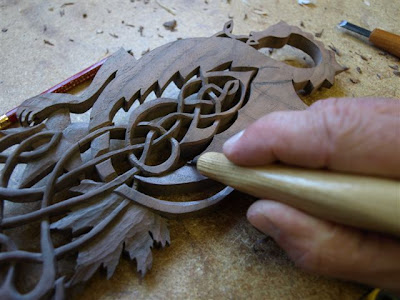
Here I cut down a section to separate the back wing from the front wing. Visually, the back one should overlap the little visible section of the front wing just as the reverse has happened on the front of the spoon. Confusing? It can get that way if you don't sketch things out! As I'm only working to 2.5D and not a full on 3D, I will keep the wings as opposite faces of the spoon, rather than trying to separate them completely. If the spoon were a bit thicker and I wasn't concerned about it getting too delicate, I would be inclined to do separated wings. Doing that would leave me with very thin wings which would be extremely susceptible to breakage...probably not a good thing for a dragon who is going to brave the hurly burly of an Eisteddfod evening!

With the facets of the wing marked out and the front portion clearly deliniated, I can start getting set to shape each section of the wing.

I have started to clear out material to create each fold of the wing. I use the bent knife to do the bull work and then smooth things out with a straight knife or with a bent knife with a shallow curve. I like to leave the surface a bit textured as it makes the wing look a bit more lively and a bit less processed than dead smooth faces. I generally cut from the bottom fold and move up to the top of the wing. That way, if I have a knife slip and take a bit off the fold in front, it isn't as calamitous a situation as it is to whack a finished section!

And thar she be. This is far as I will take the wing for the time being. After the spoon is pretty well completed, I'll come back over any rough areas and tidy things up for the final inspection, but this is pretty good for the moment.


These two pictures show the effect I am after with the wings passing over each other. A bit more exciting than 2D but not as dangerous as 3D! But don't despair if you are like a car racing fan who has come to see the pile-ups....I may have got this far unscathed, but there are plenty of opportunities for disaster still to come! It's what makes lovespoon carving the thrilling pastime it is!!
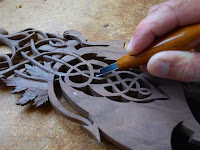 I'm working on cleaning up the Celtic knotwork this week. As with the front face, I plan to only go around the pattern cutting to a shallow depth until I am satisfied that all the 'overs and unders' are correctly placed. As with the vinework lower down, I have to make sure I am doing the exact opposite over under detail to the front face or it gets quiet seriously out of hand.
I'm working on cleaning up the Celtic knotwork this week. As with the front face, I plan to only go around the pattern cutting to a shallow depth until I am satisfied that all the 'overs and unders' are correctly placed. As with the vinework lower down, I have to make sure I am doing the exact opposite over under detail to the front face or it gets quiet seriously out of hand.
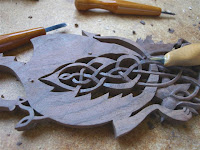 Once I am satisfied that all is going to plan, I commit to deeper cuts and make the over and under sections much more visible and bold. I generally like to work my way around the entire knot to make sure nothing gets forgotten before I worry too much about cleaning the cuts up too much.
Once I am satisfied that all is going to plan, I commit to deeper cuts and make the over and under sections much more visible and bold. I generally like to work my way around the entire knot to make sure nothing gets forgotten before I worry too much about cleaning the cuts up too much.

With all the overs and unders cut out, I can start to smooth out the 'ramps' so that the transitions are nice and fair. I also can start putting a light chamfer on the edges to soften out the hard edge of the knot. As with the front of the spoon, I am after a nice, crisp look which isn't too hard. The light chamfer gives the knot a subtle softening but it doesn't round it over so much that the knot takes on the shoelace look.
It's a personal thing which you are quite welcome to disagree with, but I find Celtic knots which have been rounded so much that they look like string or shoelaces have kind of a hokey, 'amateur' look to them. I'm sorry to any I might offend who enjoy that lkind of look, but I always find that excessively rounded knotwork also tends to look excessively worked and to use a theatre expression, rather overwrought! For me, the result is something like I would imagine would happen if Joan Rivers played Ophelia in Hamlet.

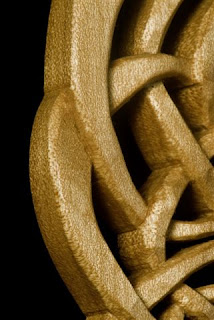
It really only needs the subtlest of chamfers to really soften the look and to lighten up the knotwork.
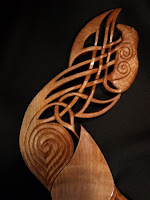 In the following couple of pictures, I hope to show some approaches to carving Celtic knotwork with keep the feel of wood rather than making the spoon look like it has been laced up. In this detail, a swirling Celtic spiral opens up and becomes a series of knot interlacings. Here, I have varied the width of the various knot strands to create some tension and to break up the monotony which would occur if they were all identical width.
In the following couple of pictures, I hope to show some approaches to carving Celtic knotwork with keep the feel of wood rather than making the spoon look like it has been laced up. In this detail, a swirling Celtic spiral opens up and becomes a series of knot interlacings. Here, I have varied the width of the various knot strands to create some tension and to break up the monotony which would occur if they were all identical width.

I often like to vary the width within an individual strand and find that making the knot a bit bulbous as it bends gives it an organic liveliness. I also find when I do my knotwork like this that it has a really nice organic feel almost like it is structured vine. The variations in line width are definitely eye-catching and vibrant!

This final knotwork picture is from a couple of lovely spoons carved by one of my lovespoon heroes, Alun Davies. Alun's knots are stunning for their even, clean line and the beautiful soft doming effect he puts on the upper face. Although the edges of his knots are only ever-so-slightly eased, the effect he achieves is a very square knot which is at the same time extremely soft and 'touchable'. I have yet to see a carver anywhere who can equal his deft touch!
Knotwork is admired and valued for its complexity of pattern, but equally important is the finish. Like so many things, it is often much better to do a simple thing really well than to do a complicated thing half-assed. I recommend to anyone wanting to try their hand at Celtic knotwork to start with some simple ones and work on getting them as clean and vibrant as possible. Once the simple ones look good, move up in difficulty a step or two at a time.
On the subject of a step or two at a time.... I am carving this spoon to raise funds in support of the Left Coast Eisteddfod, a showcase of Welsh culture to be held in Portland Oregon this August 22 weekend. Putting on an event of this calibre isn't easy and any and all support is welcome! If you have been enjoying this blog (and better yet, if you have been learning some carving/designing tricks from it) I hope that you will consider donating a few dollars to help fund what can become an exciting annual event. Every dollar you donate will give you a chance to win the finished Dragon spoon as well as to receive thanks and adoration.
 I want it and I thought others might, too!
I want it and I thought others might, too!
AmeriCymru Member Keith Underwood cycling across Wales to raise funds for Bobath Childrens Therapy Centre Wales
By gaabi, 2009-05-25
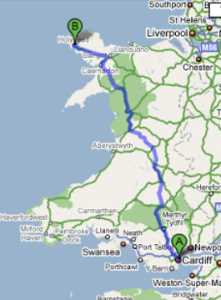
The other day, while she examined some lovespoons I had on display, I overheard a young girl saying to her friend, "Wooden spoons? What's with that?" Sadly, the romance and the whole love message idea of them went right over her head. Even after I valiantly tried to explain the history and meaning of them in a snappy Coles Notes version, I could tell she really didn't get it. Although the rest of the day went much better than that and the majority of visitors to my booth were effusive in their appreciation of the lovespoon tradition, that little girl weighed heavily on my mind. I'm no luddite, but I find it a little bit sad when I encounter people who would rather an Ipod or a bog-standard diamond ring to a wooden gift which has been hand made and is loaded with subtle meaning. I even understand them. Day in and day out we are bombarded with ads and propaganda telling us what to buy and what is in fashion (and let's be honest, handmade wood stuff is not particularly fashionable)...the commercial gift industry is both slick and persuasive...and after all, who wouldn't want an Ipod?
But I'm going to use the spoon shown here today to show you why some 'dime a dozen' mass produced diamond ring which may even have blood on it can NEVER compete with the power of these delicate pieces of wood.
What really makes this spoon special is something that you can't see. Rather than putting together a series of symbols or meaningful images, this spoon was designed to capture a feeling. For the couple who commissioned it, the spoon is a remembrance of a single significant event in a lifetime of memories. For you and I, it is a nice walnut spoon with a cheerful yellow cedar inlay and some nice Celtic knotwork. For them, it is the memory of a long-ago walk on a wintery moonlit night when the promises of a life-long love were made.
The spoon begins with an obvious and easily understood symbol. The heart shaped bowl signifies the unity and strength of their love joined as one. Even to those of us unaware of the true meaning hidden in the spoon, the heart lets us know this spoon is about love. The little diamond above the bowl is another traditonal theme. It is a wish for prosperity, but it indicates the kind of prosperity which doesn't come with money alone. It symbolizes the richness of a full and happy life shared with someone who has won your heart and who has given their heart in return.
Celtic knotwork is a modern addition to the lovespoon vocabulary which is often used to symbolize eternal love. While that is completely relevant on this spoon, the knots here create a valley which the couple gazed down into on that distant night. The valley came to be a significant symbol of separation for the couple when they were parted, but as they are now reunited, so the valley walls are now linked by the knotwork.
The yellow cedar inlay moon is the most significant feature of the design. Inlayed into the centre of the walnut, it is visible behind walnut knotwork from both sides of the spoon. The moon itself is carved with an 'eternal' Celtic knot to symbolize the never-ending nature of their love; its brightness against the dark grain of the walnut a reminder of the brightness and promise of that night. As the light travels down into the valley, the walnut knotwork surrounds it and acts to symbolically carry the moon's light into that winter night.
Could an Ipod or a diamond bring the magic of that night and all the feelings and emotions it holds back to our couple like this wooden spoon has? I seriously doubt it and for that I am thankful that there is wood in the world and the tradition of working it this way.
"Wooden spoons? What's with that?" Sorry kid, you're missing out.
 Congratulate the Devil , Howell Davies, (2008) Parthian Library of Wales
Congratulate the Devil , Howell Davies, (2008) Parthian Library of WalesThis Howell Davies science fiction novel was originally published in 1939 and has been re-published in paperback by Parthian Books under their Library of Wales imprint.
Congratulate the Devil is a revelation: engaging, unique, relevant and vibrant, seventy years after its initial publication. The narrative is subtle, darkly humorous and cheerfully bitter. Davies solidly built his characters: mannerism by action by reaction, as protagonist James Starling evolves steadily and subtly, from useless playboy to doomed and unwilling witness to tragedy and, ultimately, himself its victim. Starling visits a friend from his school days, Roper, to find that Roper, now a chemist, has made the startling discovery of a new drug which gives its user omniscient control over the actions and attitudes of others. Use of the drug also alters its user and provides Davies his platform to discuss which has greater effect and so is more destructive: malignant lust or good intention.
This new edition includes a marvelous, sparkling foreward by Howell Davies' grandson, Adrian Dannatt. Rather than another writer's hopefully very interesting impressions of the book, the author and the author's style or ability, Dannatt shares with us memories of his grandfather, intimate snapshots of Howell Davies as an individual that no acquaintence or contemporary could provide.
Congratulate the Devil is a classic, "Golden Age", sci-fi masterpiece of the 1930s, easily on par with any other work of its time and which never received the recognition it deserved. Unlike its American counterparts of the Joseph Campbell era, Davies novel is not pulp, it's a novel. There aren't any spaceships, aliens or gadgets and the science in the story is not the focus, its details and particulars are barely described. Fictional science is the catalyst that directs all the characters' narrative thereafter but the characters, their interaction, their fates and how they are effected by a product of science, are the story.
Parthian's Library of Wales series features works of Anglo-Welsh literature (works by Welsh authors in English) and their catalog can be found here .
"Nothing remains for me now but to congratulate the Devil on all his works." Howell Davies (1939)
This week I'm continuing my work on the back face of the Left Coast Eisteddfod spoon with more work on the vines and some shaping of the maple leaf and the star.

Before committing to the knives, I am careful to mark the overlaps with a pencil. I also want to draw the path of the vine across the leaf and star so that I can remember to carve it later! Because I want the dragon's tail to be uninterrupted on the front face, I didn't bother with too much over/under where the vines merge into the celtic knot. If I wasn't so interested in keeping the flow of the tail, I could have overlapped these a bit more but it would have broken things up a bit.

With the lines penciled out, I use my small straight knife held also in a pencil grip to scribe the lines to a depth of approximately 1/16th of an inch. This keeps the sides of the vines pretty vertical, marks out the path of the vines and gives me a line to start cutting against when I start lowering the leaf and the star.

In this picture I have begun cutting down the leaf using the straight cut along the vine as both a guide and stopping point. With my leaves, I resist the urge to really thin them down as my spoons are generally subjected to regular handling and an excessively thin leave becomes a breaking hazard. I try to achieve the illusion the spoon is thin by tapering toward the edges, but I still leave enough thickness that the leaf can handle rough treatment. When the spoon is viewed from the front or back, the leaf will look pretty thin and 'flowing', but when viewed from the side it will be apparant that it is a bit more substantial.
If I knew the spoon wouldn't be touched, I would thin foliage details to the very minimum. However, handling these spoons is part of their pleasure, so sometimes a little aesthetic sacrifice has to occur for the guarantee of security!

With the leaf, star and vines roughed out, I can begin to define things a bit. The vines start getting rounded over and the leaf will get a bit of texturing as it is thinned out. I'm rounding each leg of the star a bit to give it a softer feel than the more 'sheriff's badge' look the front face has and to give the back of the spoon a more organic feel.

This picture shows the 'organic' section of the spoon nearly completed. Once the rest of the spoon is complete, I'll return to this area for a final touch-up and to do some last minute shaping and sanding of the rounded edges on the vines. I hope that you have been enjoying this little blog and that following the creation of this spoon will encourage you to donate to the Left Coast Eisteddfod. It's easy to do and might win you this spoon!
